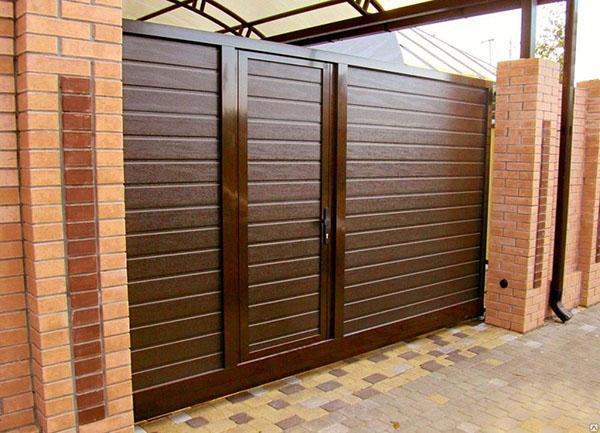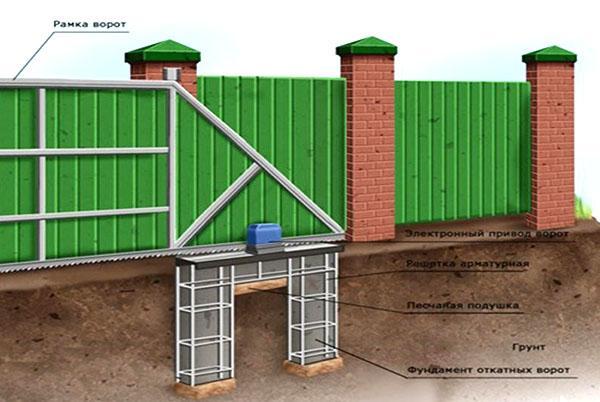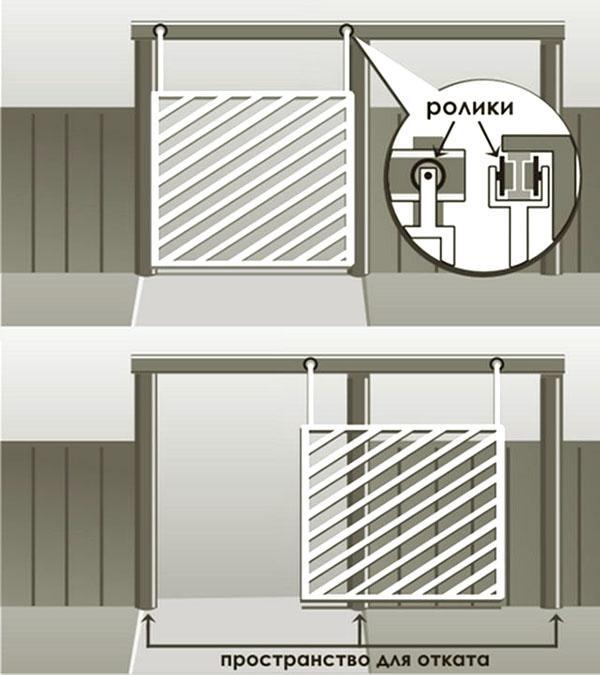Features and types of sliding gates with a wicket
 When installing a fencing of the local area, the question of choosing a gate is the most relevant. The best option for the passage equipment is a sliding gate with a wicket. They are easy to use, have an aesthetic appearance, and when open, do not clutter up the space. In addition, when operating them, the risk of damage to the vehicle is minimized. Read about installing sliding gates with your own hands on our website!
When installing a fencing of the local area, the question of choosing a gate is the most relevant. The best option for the passage equipment is a sliding gate with a wicket. They are easy to use, have an aesthetic appearance, and when open, do not clutter up the space. In addition, when operating them, the risk of damage to the vehicle is minimized. Read about installing sliding gates with your own hands on our website!
Sliding gate design with wicket

Structural elements of sliding gates with a wicket:
- rectangular frame;
- one-piece sheet with a hole for a wicket;
- a wicket with a mock bar;
- guide skids;
- a pair of roller bearings installed in the foundation;
- electric drive.
For the movable leaf of sliding gates, steel or profiled sheet is most often used. It is fixed in a power frame, which is made of a shaped tube. The gate for the passage of people is designed during the drawing up of the drawing of the sliding system.
It is advisable to install a wicket in a sliding gate when it is not possible to equip it nearby. However, it cannot be placed very close to the edge and placed in the center of the structure. Its usual location is a meter from the edge of the gate.
Types of sliding gates
The movable leaf of a sliding gate with a wicket is designed in three versions:
- Suspended. The design of fixing the movable sash provides for its connection with the upper guide rail at a level of 3-5 meters. The height of the hanging gate is determined by the type of object. The disadvantage of such an opening system is the restriction of the opening in height, which affects the passage of large vehicles.

- Retractable on the rail. The opening mechanism is made by means of a rail mounted on the ground, along which the entire structure moves. The sliding sash is held by a roller bracket attached to the post. Disadvantage - can not be used in areas with increased wind load.

- Console. The design of sliding metal doors with a wicket is supported by a beam connected to vertical supports by means of roller trolleys. Supports are installed on the foundation to the side of the opening. The guide block can be installed at the bottom, top or in the middle of the movable sash.

For gates with a sliding principle of opening, it is extremely important to have free space along the fence. For suspended and rail structures, its length should be equal to the length of the movable leaf, for cantilever gates - this gap should be 2 times larger.
Advantages and disadvantages of sliding gates
 The advantages of sliding gates with a built-in wicket are obvious:
The advantages of sliding gates with a built-in wicket are obvious:
- compactness and reliability of the design;
- the ability to install a wicket in a place convenient for people to pass (but not in the center);
- smooth and silent movement of the movable sash;
- resistance to negative manifestations of nature;
- ease of maintenance;
- the choice of material for the movable panel;
- long period of operation.
Among the disadvantages it is worth noting:
- installation of sliding gates with a wicket, in comparison with other types of gates, requires large financial investments;
- for the installation of the cantilever part of the sliding system and the drive, it is necessary to install a concrete foundation;
- at the design stage, a free area should be provided along the fence to roll back the sash.
The nuances of wicket installation
 A wicket built into the sliding gates allows people to enter and leave the fence without activating the sliding system. On the one hand, it is beneficial and visually attractive, and on the other hand, it has a number of nuances that should be taken into account even at the stage of designing a sliding gate with a wicket with your own hands:
A wicket built into the sliding gates allows people to enter and leave the fence without activating the sliding system. On the one hand, it is beneficial and visually attractive, and on the other hand, it has a number of nuances that should be taken into account even at the stage of designing a sliding gate with a wicket with your own hands:
- the sliding system does not work when the gate is open;
- due to the limited distance between the gate leaf and the supporting structure, the choice of door handle and lock is limited;
- a high threshold suggests pedestrians to step over it and prevents the free movement of a bicycle, a trolley on wheels, a wheelchair;
- for tall people, the upper crossbar becomes an obstacle to free movement, forcing them to bend down before entering / exiting;
- in sliding gates, the wicket significantly affects the weight of the structure, which reduces the rigidity of the frame.
To maintain the rigidity of the structure, you should use profile pipes with a wall thickness of at least 3 mm and with a large cross-section, for example, instead of the usual size of 60x30 mm, you need to take 60x40 mm, 50x50 mm, 60x60 mm, but not more. Also, to minimize deformation of the canvas, it is worth giving preference to the cantilever type of sliding gates.
Usually the wicket is made of the same material as the door leaf. Its width is made from 80 to 1 meter. The opening is laid in the yard. On the outside, a false bar is laid to prevent the door from opening. The lock is installed mechanically, the handle is selected to the minimum size or installed in a recessed way.
Below are a few photos of a sliding gate with a wicket inside:

